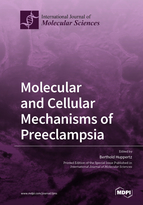Molecular and Cellular Mechanisms of Preeclampsia
A special issue of International Journal of Molecular Sciences (ISSN 1422-0067). This special issue belongs to the section "Molecular Pathology, Diagnostics, and Therapeutics".
Deadline for manuscript submissions: closed (31 October 2019) | Viewed by 116733
Special Issue Editor
Interests: cell biology; morphology; apoptosis; human placenta; trophoblast; invasion; preeclampsia; IUGR
Special Issues, Collections and Topics in MDPI journals
Special Issue Information
Dear Colleagues,
Despite massive research efforts during recent decades, preeclampsia has remained the syndrome of hypotheses. Today, the etiology of the pathways resulting in the clinical symptoms hypertension and proteinuria still remains obscure. Over time, a number of very promising hypotheses have been developed, but so far not a single hypothesis has been accepted. The current hypotheses range from shallow trophoblast invasion, which is believed to result in placental hypoxia, to defects of the villous trophoblast resulting in the release of necrotic particles affecting the maternal endothelium, to a maternal failure to adapt to the stress test pregnancy. This Special Issue will summarize all hypotheses and will leave it to the readers to identify the most conclusive explanation.
Prof. Dr. Berthold Huppertz
Guest Editor
Manuscript Submission Information
Manuscripts should be submitted online at www.mdpi.com by registering and logging in to this website. Once you are registered, click here to go to the submission form. Manuscripts can be submitted until the deadline. All submissions that pass pre-check are peer-reviewed. Accepted papers will be published continuously in the journal (as soon as accepted) and will be listed together on the special issue website. Research articles, review articles as well as short communications are invited. For planned papers, a title and short abstract (about 100 words) can be sent to the Editorial Office for announcement on this website.
Submitted manuscripts should not have been published previously, nor be under consideration for publication elsewhere (except conference proceedings papers). All manuscripts are thoroughly refereed through a single-blind peer-review process. A guide for authors and other relevant information for submission of manuscripts is available on the Instructions for Authors page. International Journal of Molecular Sciences is an international peer-reviewed open access semimonthly journal published by MDPI.
Please visit the Instructions for Authors page before submitting a manuscript. There is an Article Processing Charge (APC) for publication in this open access journal. For details about the APC please see here. Submitted papers should be well formatted and use good English. Authors may use MDPI's English editing service prior to publication or during author revisions.







